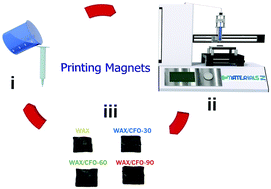当前位置:
X-MOL 学术
›
J. Mater. Chem. C
›
论文详情
Our official English website, www.x-mol.net, welcomes your
feedback! (Note: you will need to create a separate account there.)
Reconfigurable 3D-printable magnets with improved maximum energy product
Journal of Materials Chemistry C ( IF 5.7 ) Pub Date : 2019-12-20 , DOI: 10.1039/c9tc06072c R. Brito-Pereira 1, 2, 3, 4, 5 , C. Ribeiro 1, 2, 3, 4, 6 , N. Peřinka 7, 8, 9, 10, 11 , S. Lanceros-Mendez 7, 8, 9, 10, 11 , P. Martins 1, 2, 3, 4, 12
Journal of Materials Chemistry C ( IF 5.7 ) Pub Date : 2019-12-20 , DOI: 10.1039/c9tc06072c R. Brito-Pereira 1, 2, 3, 4, 5 , C. Ribeiro 1, 2, 3, 4, 6 , N. Peřinka 7, 8, 9, 10, 11 , S. Lanceros-Mendez 7, 8, 9, 10, 11 , P. Martins 1, 2, 3, 4, 12
Affiliation

|
In conventional magnets, neodymium with added heavy rare-earths is used in order to induce high output and size reduction. But as deposits of heavy rare-earths such as dysprosium (Dy) and terbium (Tb) are disproportionately distributed, it is important to reduce the amount used due to supply issues and material costs. Additionally, the use of rare-earths in applications that only need modest magnetic properties is disadvantageous and complicates their low-cost production in on-demand shapes. In this paper and as a new concept, reconfigurable rare-earths-free Wax/CoFe2O4 composite magnets were fabricated through 3D-printing. The evolution of magnetic properties was studied as a function of the magnetic field and CoFe2O4 ferrite content, allowing one to tune the magnetic response of permanent magnets. It was shown that saturation and remnant magnetization increase monotonously with ferrite content, reaching maximum values of 38.6 emu g−1 and 22.1 emu g−1, respectively, for the sample with 90% in weight of CoFe2O4 (wt%). On the other hand, the coercive field (≈2500 Oe) remained constant for all samples. Additionally, the addition of ferrite nanoparticles into Wax increased the Young's modulus (from 0.06 GPa to 0.47 GPa) and improved the thermal stability of the matrix as shown by the increase of the maximum degradation rate temperature and the temperature at which 25 wt% of the sample is degraded (from 412 °C to 429 °C and from 393 °C to 424 °C, respectively). In addition, the (coercive field) × (remanence field) maximum energy product (HC × BC)MAX, which is the figure of merit of permanent magnets, was evaluated, with the value obtained being the highest reported in the literature for CoFe2O4-based magnets (i.e., 4.44 MG Oe for the sample with 90 wt% of ferrite content). Thus, the present study allowed one to establish a new way to prepare reconfigurable printable magnets based on Wax/CoFe2O4 nanoparticles for advanced technologies.
中文翻译:

可重新配置的3D可打印磁体,具有更高的最大能量积
在常规磁体中,为了增加产量和减小尺寸,使用了添加了重稀土元素的钕。但是,由于heavy(Dy)和ter(Tb)等重稀土的沉积物分布不均,因此,由于供应问题和材料成本的原因,减少用量非常重要。另外,在仅需要适度的磁性的应用中使用稀土是不利的,并使按需形状的低成本生产复杂化。在本文中,作为一个新概念,通过3D打印制造了可重构的无稀土Wax / CoFe 2 O 4复合磁体。研究了磁性能随磁场和CoFe 2 O 4的变化铁素体含量,可以调节永磁体的磁响应。结果表明,对于重量为90%的CoFe 2 O 4样品,饱和度和剩余磁化强度随铁素体含量单调增加,分别达到38.6 emu g -1和22.1 emu g -1的最大值。(重量%)。另一方面,所有样品的矫顽场(≈2500Oe)保持恒定。另外,向蜡中添加铁氧体纳米颗粒增加了杨氏模量(从0.06 GPa到0.47 GPa),并改善了基体的热稳定性,这是通过最大降解速率温度和25%(重量)的最高温度的增加来表明的。样品降解(分别从412°C到429°C和从393°C到424°C)。此外,还评估了(矫顽场)×(剩磁场)最大能量乘积(H C ×B C)MAX,它是永磁体的优值,其获得的值是文献中报道的最高值。基于CoFe 2 O 4的磁体(例如,铁氧体含量为90 wt%的样品为4.44 MG Oe。因此,本研究允许人们建立一种新方法来制备基于Wax / CoFe 2 O 4纳米粒子的可重构可印刷磁体,用于先进技术。
更新日期:2020-01-13
中文翻译:

可重新配置的3D可打印磁体,具有更高的最大能量积
在常规磁体中,为了增加产量和减小尺寸,使用了添加了重稀土元素的钕。但是,由于heavy(Dy)和ter(Tb)等重稀土的沉积物分布不均,因此,由于供应问题和材料成本的原因,减少用量非常重要。另外,在仅需要适度的磁性的应用中使用稀土是不利的,并使按需形状的低成本生产复杂化。在本文中,作为一个新概念,通过3D打印制造了可重构的无稀土Wax / CoFe 2 O 4复合磁体。研究了磁性能随磁场和CoFe 2 O 4的变化铁素体含量,可以调节永磁体的磁响应。结果表明,对于重量为90%的CoFe 2 O 4样品,饱和度和剩余磁化强度随铁素体含量单调增加,分别达到38.6 emu g -1和22.1 emu g -1的最大值。(重量%)。另一方面,所有样品的矫顽场(≈2500Oe)保持恒定。另外,向蜡中添加铁氧体纳米颗粒增加了杨氏模量(从0.06 GPa到0.47 GPa),并改善了基体的热稳定性,这是通过最大降解速率温度和25%(重量)的最高温度的增加来表明的。样品降解(分别从412°C到429°C和从393°C到424°C)。此外,还评估了(矫顽场)×(剩磁场)最大能量乘积(H C ×B C)MAX,它是永磁体的优值,其获得的值是文献中报道的最高值。基于CoFe 2 O 4的磁体(例如,铁氧体含量为90 wt%的样品为4.44 MG Oe。因此,本研究允许人们建立一种新方法来制备基于Wax / CoFe 2 O 4纳米粒子的可重构可印刷磁体,用于先进技术。











































 京公网安备 11010802027423号
京公网安备 11010802027423号